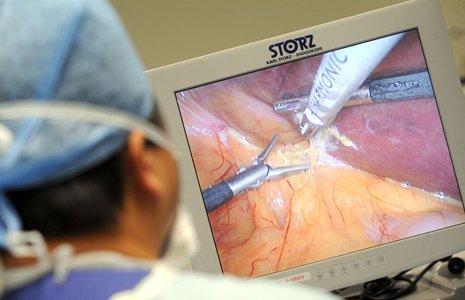Touchless gaming technology in trial for delicate keyhole surgery
British doctors from St Thomas’ hospital in London are trialling “touchless” technology, often used in TV games, to help them carry out delicate keyhole surgery.
The system allows them to manipulate images with their voice and hand-gestures rather than using a keyboard and mouse.
Surgeons say it gives them more control and avoids disruption.
Independent experts say this approach could become the norm over the next ten or 15 years.
Surgeons are increasingly reliant on 3D images to carry out complex and delicate procedures.
Accessing the information they want is not straightforward. Using a conventional keyboard and mouse during the operation would risk contamination.
Relying on colleagues to get the right image can be time-consuming and disruptive.

Doctors from St Thomas’ hospital in London are trialling "touchless" technology, often used in TV games, to help them carry out delicate keyhole surgery
Surgeons are trialling gesture-based gaming technology to access and manipulate images.
The system will be familiar to anyone who has used Kinect interactive games at home.
This has been adapted to respond to surgeons’ voice commands and arm-movements during operations.
The initial trial at St Thomas’ hospital is in vascular surgery – in this case inserting a graft to repair a damaged aorta, the main blood vessel running through the body.
Standing straight, arms raised like an conductor, the surgeon, Tom Carrell, issues commands to a Kinect sensor perched beneath a monitor displaying a 3D image of the patient’s damaged aorta.
With hand gestures he can pan across, zoom in and out, and rotate images. He can then lock the image and make markers to help ensure the graft is in exactly the right place.
He says this direct control helps him to focus on the technical aspects of the operation.
“Until recently I was shouting out across the operating theatre to tell someone to go up, down, left right.
“But with the Kinect I’m able to get the position that I want quickly – and also without me having to handle non-sterile things like a keyboard or mouse during the procedure.”
Dr. Tom Carrell says the technology is easy to use.
“The sensitivity is the main thing, but it’s very simple gestures, like on a smart-phone. Once you know the gestures it’s very intuitive.”
This is one of the first trials of its kind in the world. Some of the features – such as the voice control and gestures tailored to vascular surgery – are unique.
The refinements from gaming technology to complex surgery have been developed by Microsoft Research, with support from Lancaster University. Helena Mentis from Microsoft Research says the operating theatre presents particular challenges.
“In something like a surgical theatre we’re interested in a very constrained area. You have surgeons and scrub nurses that are all very close to one another.
“You have a patient in front of you. You don’t have the ability to reach up and reach out as far because you’re sterile. You can’t touch anything that’s not already sterile.”
